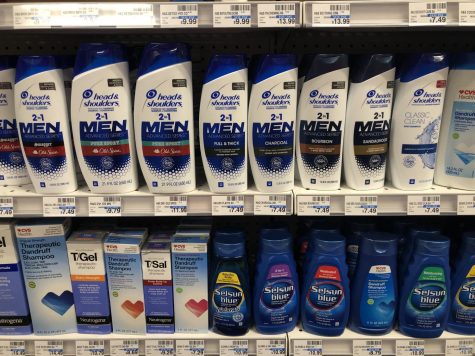The Pitt Prescription: Caring for dry skin and dandruff
The Pitt Prescription is a bi-weekly blog where student pharmacist and Senior Staff Writer Elizabeth Donnelly provides tips on how to stay healthy in college. This edition was reviewed by Karen S. Pater, PharmD, CDCES, BCACP.
Shruti Talekar | Contributing Editor
The Pitt Prescription
January 12, 2020
Every year, when the temperature starts to drop outside, I start to carry a travel-sized bottle of lotion with me wherever I go. As it gets colder and colder, it seems like my skin dries out no matter what I do, so having a constant supply of moisturizer is quite handy.
The skin is the largest human organ — with a total area of around 20 square feet, it acts as the body’s natural defense against the environment, which is why it’s important to take care of it. Drinking water, eating a nutritious diet and using skincare products can all aid in taking care of your skin, especially during the winter.
Causes of dry skin
Dry skin is one of the most common skin conditions — known in the medical world as xerosis — and it can affect anyone regardless of their age, gender or medical history. This condition can be caused by a number of factors, but some of the most common are weather, heat, hot baths or showers, harsh soaps or pre-existing skin disorders like psoriasis.
Weather is often a significant factor that contributes to dry skin — in the winter, the temperature and humidity often both decrease, which can cause excessive drying of the skin due to the air pulling the moisture out of the skin. Some people may have an elevated risk for dry skin due to social factors like their age, location in which they live, job and hobbies.
As people age, the body has a harder time retaining moisture in the skin, which means older adults can be more susceptible to dry skin. People who live in low-humidity and colder environments or who have jobs involving contact with water are also at a higher risk for dry skin. As someone who has lived in Chicago and taught a swimming class during the winter, I can definitely attest to these factors increasing the formation of dry skin. Lips are also vulnerable to cracking, drying and irritation as they are constantly exposed to the elements and do not contain any sweat or sebaceous glands.
Luckily, dry skin is often not a serious or harmful condition. In severe cases, when dry skin is not cared for properly, it may lead to an eczema flare-up or to infections if the skin cracks and allows bacteria to enter. Caring for dry skin is typically an easy process and can be done with readily available drugstore products.
Treatment of dry skin
Prevention is key when it comes to dry skin. In order to prevent excessive drying, the goal is to raise the water level in the skin and to ensure that the skin is able to retain water. Moisturizing your skin several times a day can help trap water in the skin and keep it from escaping. Moisturizing creams are often recommended for dry skin, with oil-based creams typically better at holding in moisture. It is recommended to moisturize directly after taking short, lukewarm showers. Staying hydrated by drinking six to eight glasses (about 64 ounces) of water per day and avoiding caffeine — which can dehydrate you — can help.

Most drug stores, like Rite Aid and CVS, offer many different moisturizing products to help care for dry skin.
Hot water or prolonged water exposure is also a cause of dry skin, so shortening shower time and using cooler water can help, as well as avoiding saunas or hot tubs. Once out of the shower or bath, apply an occlusive agent — or something that cannot go through the skin — like petrolatum or lanolin. This will promote water retention in the skin. Be mindful of the types of soap you use when washing your hands — try to use gentle cleansers or soaps with added moisturizers to avoid harsh chemical effects on your skin. When using cleaning products like dish soap or floor cleaner, using rubber gloves will protect your hands from the harsh ingredients as well. Keeping the room air humidified and room temperature low can also help prevent or lessen dry skin.
While the hands and face are often the most affected by dry skin, your whole body is susceptible, especially in the winter. Another major part of your body that can lose moisture is your scalp. This leads to something that anyone with dark hair dreads — dandruff.
Causes of dandruff
Dandruff can be caused by many things, like not shampooing enough or the yeast malassezia, but a common cause in the wintertime is dry skin. It presents differently in many people, but signs of dandruff include skin flakes on your scalp, hair, eyebrows and/or shoulders and an itchy scalp. These symptoms can be worsened in times of stress and in cold, dry seasons.
Treatment of dandruff
Like dry skin, dandruff is a condition that has many easily accessible treatments. The most commonly known treatment is using a dandruff-controlling shampoo. Many brands are available and contain differing medications. Shampoos containing selenium sulfide, pyrithione zinc, ketoconazole — an antifungal — or salicylic acid are all marketed as dandruff remedies.
The most commonly known shampoo for dandruff is Head & Shoulders Intensive, which contains selenium sulfide. However, there are many others like Nizoral, Selsun Blue or DermaZinc that have different active ingredients and can treat dandruff. Different shampoos will work better for different people, so it can be a trial and error process into finding one that works best for you. The most important thing to keep in mind is that for many of these products, the key to success is to get adequate contact between the medicated shampoo and the scalp. It is best to massage the shampoo into the scalp and leave it on for 3-5 minutes. Be sure to read the package label and follow the instructions for best results.

A variety of dandruff controlling shampoos can be found at most local drug stores, like Rite Aid or CVS.
There are alternative methods to controlling dandruff in combination with using shampoos. They include dietary and lifestyle changes. Mayo Clinic recommends learning to manage stress, which can trigger or worsen symptoms of dandruff. Additionally, eating a well-rounded diet with sufficient vitamins and nutrients, like zinc and B vitamins, can help with prevention. Finally, shampooing often and limiting hair products may help ease dandruff.
If your dandruff persists for several weeks after trying different treatments, you should talk with a doctor or pharmacist about prescription-level alternatives.
Dry skin and dandruff can be uncomfortable side effects of the winter season, but making sure to keep your skin healthy and moisturized can be an effective way to treat these skin conditions. I personally use a heavy moisturizing cream right after I wash my face in order to keep as much moisture in my skin as possible. If you need over the counter, reliable suggestions for dandruff or dry skin products, you can go to any local pharmacy and ask for assistance to find the product that is right for you.



